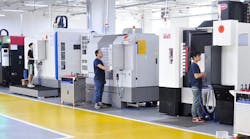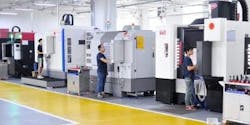Consider machine-shop efficiency as how the resources are used and converted to a valuable product, compared to the waste generated throughout the processing. Examples would be the ratios of: how many piece parts are made compared to how many were scrapped, how much of the labor hours are used for value-adding tasks compared to how much is used for the non-value adding tasks, how much time is spent setting up a part compared to how much time will it be machined, and so on.
In other words, an efficient CNC machine shop maximizes the resources at hand while eliminating/ minimizing the wastes produced.
Factors that affect the productivity of a CNC machine shop
Many machining facilities may not realize how much they can improve their productivity. The key to starting improvement is by being aware of the different driving factors along a manufacturing line. Below find are some factors that affect the overall productivity of a CNC machine shop:
Technical and production planning—Technical and production planning is a crucial factor for a fabrication process because prior to pushing through with all the processes in the CNC machine shop, it must first pass through this stage. This dictates the flow of a manufacturing plant, from where and how the process starts and ends. Planning drives how effective the allocation of all available resources will be.
Inventory—Inventory is also one of the major factors where many manufacturing wastes may be coming from. Poor inventory management causes significant losses regarding time and space resources, which results from unforeseen stock offs and stock delays. The inventory in a machine shop includes cutting tools, replacement parts, and raw materials.
Operator efficiency—Human resources also affect a machine shop's productivity in two ways: man-to-machine ratio and operator skills. Operator skills play a vital role in the successful execution of tasks in a workflow. Operator-to-machine ratio is the number of machines an operator runs. Defining the optimum ratio will help in maximizing manpower and avoid wasting unutilized talents. Idle times of either the machine or the operator means waste of resources.
Toolings and machine capability—The machines and toolings are one of the dominant resources in a machine shop. They are one of the company's major assets, wherein they take a huge chunk of responsibility in the overall production of parts. It is important to consider maximizing their capabilities because the operability of these resources defines a machine shop's profitability from a business perspective.
Tips to maximize the efficiency of a CNC machine shop
Manufacturing lines have always sought solutions to improve their production even though their process is, at its best, operability. That is why they have been continuously performing efficiently as years go by. The best process now may not be the best process in the future. The key to efficient CNC production is to always strive for continuous improvement.
Below are some tips on how a machine shop may boost its productivity:
1. 5S mindset
5S originally stands for Seiri, Seiton, Seiso, Seiketsu, Shitsuke. The English counterpart: Sort, Set in Order, Shine, Standardize, and Sustain. This is a popular Japanese lean methodology that is used to reduce waste in manufacturing and optimize productivity.
Some of the things that can be done on a shop floor are organizing the workflow and arranging the toolings to have standardized locations—for example, having a fixed and defined location for tools, workbenches, and other items. Placing all of these in strategized locations will help minimize waste from unnecessary waiting, travel and motion.
5S may also help in systematizing the whole production line of a CNC machine shop. To do so is to perform a value-stream mapping. Take note of all the processes done on a part from start to finish and sort all the steps and eliminate all the unnecessary and non-value-adding metrics.
Doing these will help raise awareness of how much waste there is in the production line. 5S helps eliminate a huge bulk of unneeded resources that may be slowing down the overall workflow of a machine shop.
2. Invest in toolings and reliable equipment
It is worthwhile to consider using high-performance cutting tools for CNC machines. They might have a high initial cost, but the return on investment for these comes in the long run where the quality of products they produce is impeccable, and the tool life is considerably longer. In addition, many fabricators attest to lessened part scrappages just by using reliable cutting tools. Investing in high-quality resources eliminates inefficiency brought by poor toolings.
3. Optimize the CNC machine's capability
CNC machines nowadays are capable of doing powerful things; sometimes resources are lost when these capabilities are not optimized. Pushing a CNC machine to its optimum performance helps significantly in increasing a shop's productivity. Minimize the cycle time of a CNC program by maximizing the tooling and machining capability. This includes using the proper tools and tweaking the parameters to their optimum performance.
4. Mature the best processes
As mentioned, one secret of an efficient machine shop is their desire for continued excellence. There is no shortcut to achieving a mature and efficient process. Everyone starts by gradually implementing improvement projects one at a time, based on what their processes need at that moment. The key is to stick to a workflow that has been established while always being open to any opportunity for process improvement.
Rita Jin is the marketing manager for WayKen




